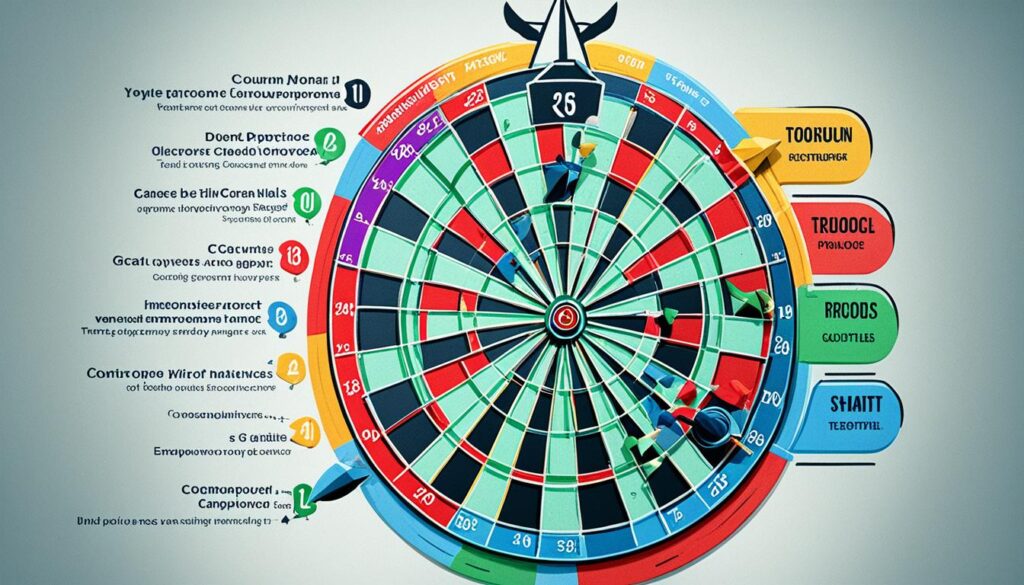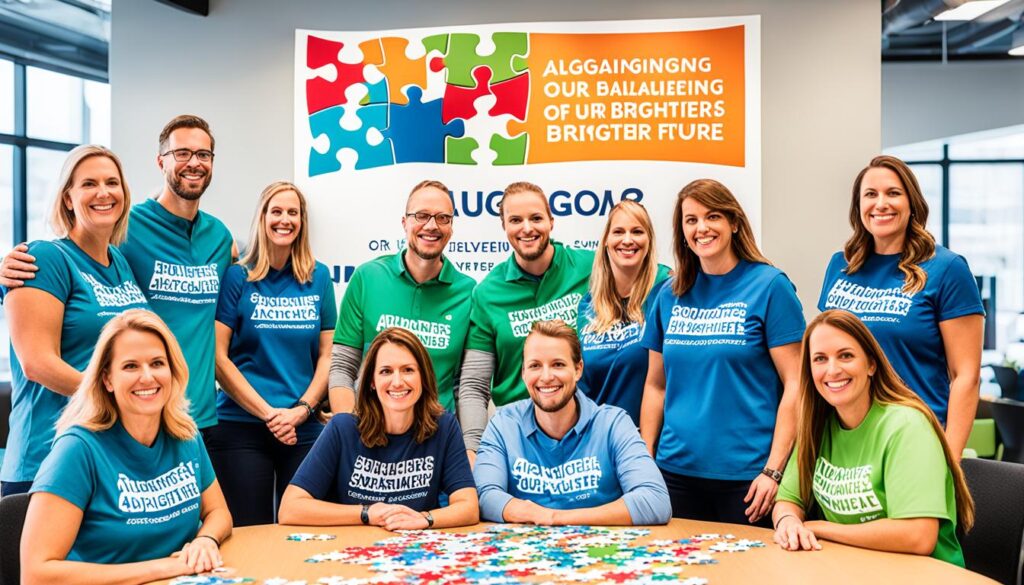Empower Your Future with Employee Goal Setting

Are you ready to unlock your full potential and take your career to new heights? Discover the power of employee goal setting and how it can transform your performance, development, and career trajectory. You might be surprised at the impact that setting clear objectives can have on your motivation, engagement, and overall success in the workplace.
Key Takeaways:
- Setting goals is crucial for enhancing workplace performance and growth.
- Performance goals focus on achieving measurable results, while personal development goals improve skills and knowledge.
- Collaboration and time management goals improve teamwork and productivity.
- Innovation and creativity goals drive growth and keep businesses competitive.
- Aligning employee goals with organizational objectives creates a shared sense of purpose.
Types of Employee Goals
When it comes to employee goal setting, it is important to understand the different types of goals that can contribute to individual and organizational success. Two primary types of employee goals include performance goals and personal development goals.
Performance Goals
Performance goals are short-term objectives that employees must strive to achieve to meet specific business goals or job responsibilities. These goals serve as benchmarks for performance evaluation and focus on achieving measurable results. By setting performance goals, employees can enhance their productivity and contribute to the overall success of the organization.
Examples of performance goals include:
- Increasing sales revenue by a certain percentage
- Reducing customer complaints by a specific number
- Improving customer satisfaction ratings
- Meeting project deadlines consistently
Personal Development Goals
Personal development goals focus on acquiring new skills, knowledge, and abilities to improve performance and contribute to the success of the organization. These goals are centered around self-improvement and enable employees to enhance their capabilities and grow professionally.
Examples of personal development goals include:
- Taking a public speaking course to improve communication skills
- Earning an advanced degree to enhance expertise
- Attending leadership training programs to develop managerial skills
- Acquiring technical certifications to expand proficiency
By setting both performance goals and personal development goals, organizations can create a balanced approach to employee growth and success. Performance goals help employees achieve specific business outcomes, while personal development goals empower employees to continuously improve themselves.
| Performance Goals | Personal Development Goals |
|---|---|
| Focus on achieving measurable results | Focus on acquiring new skills and abilities |
| Short-term objectives | Long-term growth and development |
| Align with specific business goals or job responsibilities | Contribute to the success of the organization |

The image above visually represents the importance of setting performance goals and personal development goals to drive employee growth and organizational success. By combining these two types of goals, organizations can empower their employees to perform at their best while continuously enhancing their capabilities.
Collaboration and Time Management Goals
In order to foster a productive and harmonious work environment, collaboration and time management goals play a vital role. These goals aim to improve team dynamics, enhance communication, and build trust among team members. By setting collaboration goals, managers can create a supportive and cohesive atmosphere that fosters creativity and innovation. This not only boosts productivity but also contributes to job satisfaction and overall employee well-being.
Examples of Collaboration Goals:
- Enhancing communication and trust among team members
- Improving group dynamics and teamwork
- Fostering a collaborative work environment
Effective time management is crucial for meeting deadlines, reducing stress, and increasing productivity. Time management goals help employees prioritize tasks, allocate resources effectively, and streamline processes. By improving time management skills, individuals can make better use of their working hours, leading to greater efficiency and better overall results.
Examples of Time Management Goals:
- Prioritizing tasks based on importance and urgency
- Reducing wasted time through process improvements
- Completing tasks within set deadlines
By focusing on collaboration and time management goals, organizations can create a positive work environment that maximizes efficiency and effectiveness. The alignment of these goals with overall organizational objectives ensures that teams work cohesively towards achieving common business goals.
| Benefits of Collaboration and Time Management Goals |
|---|
| Enhanced team communication and trust |
| Improved group dynamics and teamwork |
| Increased individual productivity |
| Reduced stress and better work-life balance |

Innovation and Creativity Goals
Driving growth and staying ahead of the competition requires a focus on innovation and creativity goals. By setting these goals, you inspire your employees to explore new ideas, develop groundbreaking products, and implement innovative processes that lead to business success.
Innovation goals encourage your team to think outside the box and challenge the status quo. By fostering a culture that embraces risk-taking and creativity, you create an environment where employees feel empowered to bring their unique perspectives and ideas to the table. When employees are encouraged to take calculated risks, it opens up opportunities for breakthrough innovations that can propel your organization forward.
Creativity goals are essential for nurturing a culture of innovation. By setting these goals, you provide your team with the freedom to explore new approaches, experiment with different strategies, and unleash their creative potential. When employees are encouraged to use their imagination and tap into their innovative thinking, it leads to unique solutions, novel products, and fresh perspectives.
Examples of innovation and creativity goals include:
- Developing new ideas, products, or services that address emerging market needs
- Create a culture of innovation by implementing brainstorming sessions and encouraging cross-functional collaboration
- Staying ahead of the competition by continuously upgrading products or processes to meet changing customer demands
- Applying new technologies to streamline operations and enhance productivity
Innovation and Creativity Goals
Setting innovation and creativity goals not only spurs your team to push boundaries but also fosters a sense of excitement and engagement. When employees are given the opportunity to contribute innovative ideas and take ownership of their work, it boosts morale and leads to a more motivated and inspired workforce.
Embrace innovation and creativity goals to transform your organization and unlock its full potential, propelling it towards continuous growth and success.
| Innovation and Creativity Goals | Benefits |
|---|---|
| Developing new ideas, products, or services | Stay ahead of the competition and capture new market opportunities |
| Create a culture of innovation | Foster collaboration, employee engagement, and improved problem-solving |
| Staying ahead of the competition | Position your organization as an industry leader and attract loyal customers |
| Applying new technologies | Drive operational efficiency and enhance productivity |
By leveraging the power of innovation and creativity goals, you can cultivate a dynamic and forward-thinking organization that adapts to change, seizes opportunities, and drives sustainable growth.

Aligning Employee Goals with Organizational Objectives
Aligning goals is essential for creating a unified sense of purpose and direction within an organization. By aligning employee goals with organizational objectives, you can empower your team to work towards a common vision, fostering productivity and success.
To align goals effectively, clear communication and expectation-setting are paramount. By conveying the organization’s objectives and values to employees, you ensure everyone understands and works towards the same overarching goals. This alignment ignites a sense of shared purpose and reinforces the organization’s strategic direction.
Breaking down organizational objectives into smaller, measurable tasks and linking them to individual goals is a powerful strategy. This approach helps employees understand how their work directly contributes to the company’s success. By connecting the dots between their individual efforts and the bigger picture, employees gain a deeper sense of purpose and motivation to excel.
Support, feedback, and guidance are vital components of aligning goals. Regularly providing support to employees through mentoring, coaching, and resources ensures they have the necessary tools to achieve their goals. Constructive feedback helps employees stay on track and make necessary adjustments, fostering continuous growth and improvement.
Regular reviews and adjustments are crucial to keep employees aligned with evolving organizational objectives. As priorities shift and business needs change, reviewing and updating goals help teams stay nimble and adaptable. This ongoing alignment process ensures that individuals and teams are always moving in the right direction, even in a dynamic and ever-changing business environment.

Benefit of Aligning Goals
When employee goals align with organizational objectives, several benefits follow:
- Increased employee engagement and motivation
- Improved job satisfaction and retention
- Enhanced teamwork and collaboration
- Better clarity and focus on business priorities
- Streamlined decision-making and resource allocation
By aligning goals, organizations create a cohesive and high-performing workforce where every individual is focused on achieving common objectives. The result is a productive and empowered team that drives business success.
Conclusion
Employee goal setting is a transformative strategy that empowers individuals and drives productivity in the workplace. By setting clear and achievable goals, organizations provide their teams with a sense of direction and purpose. The SMART goal-setting framework serves as a structured approach for creating actionable objectives that propel both personal and organizational growth.
In running successful goal-setting sessions, fostering a collaborative environment is key. Reflecting on past achievements and future aspirations helps employees envision their potential and set meaningful goals. Breaking down big goals into smaller, manageable tasks ensures progress and prevents overwhelm. Providing the necessary tools, resources, and support equips individuals to tackle and achieve their goals.
Implementing regular check-ins and feedback loops enables continuous improvement and alignment with evolving objectives. Celebrating achievements along the way reinforces the importance of goal setting and personal development. By involving employees in the goal-setting process and empowering them with the necessary resources, organizations cultivate a highly engaged and motivated workforce.
By embracing the power of employee goal setting, businesses can unlock the full potential of their teams and drive sustainable growth. Through collaborative goal-setting sessions and a supportive environment, organizations empower their employees to reach new heights and contribute to the overall success of the company.





